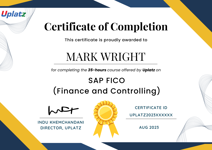
Product Owner Career Path
Self-paced videos, Lifetime access, Study material, Certification prep, Technical support, Course Completion Certificate
Uplatz
Summary
- Uplatz Certificate of Completion - Free
Add to basket or enquire
Overview
Uplatz provides this powerful and extensive Career Path program to help you become a Product Owner. It is a program covering all topics related to Product Management in the form of self-paced video tutorials. You will be awarded Course Completion Certificate at the end of the course.
A Product Owner is a key role in the Agile software development framework, responsible for defining and prioritizing the features of a product or project. They act as the primary liaison between the development team and stakeholders, ensuring that the product meets the needs of the customers and the business.
Here are some of the key responsibilities of a Product Owner:
Product Vision: The Product Owner is responsible for defining the overall vision and goals of the product. They need to have a clear understanding of the product's purpose and how it aligns with the organization's objectives.
Backlog Management: The Product Owner maintains and prioritizes the product backlog, which is a list of all the desired features, enhancements, and bug fixes for the product. They collaborate with stakeholders to gather requirements and continuously refine the backlog based on feedback and changing priorities.
User Stories: The Product Owner creates user stories, which are concise descriptions of product functionality from the user's perspective. User stories help communicate the requirements and expectations to the development team effectively.
Prioritization: One of the most crucial tasks of a Product Owner is to prioritize the items in the product backlog. They do this by considering factors such as business value, customer needs, technical feasibility, and market demands.
Communication: The Product Owner facilitates communication between the development team and stakeholders. They ensure that all parties are aligned on the product's direction and keep stakeholders informed about the progress and any changes.
Acceptance Criteria: The Product Owner works with the team to define acceptance criteria for each user story. Acceptance criteria set the specific conditions that must be met for a user story to be considered complete.
Sprint Planning: In Agile methodologies, development work is organized into iterations called sprints. The Product Owner collaborates with the team during sprint planning meetings to select and commit to a set of user stories that will be completed in the upcoming sprint.
Product Demos: At the end of each sprint, the Product Owner participates in sprint review meetings to demonstrate the completed features to stakeholders and gather feedback.
Decision Making: The Product Owner has the authority to make decisions about the product. They need to be available to the development team during the sprint for clarifications and guidance.
In summary, the Product Owner plays a vital role in ensuring that the product meets the needs of customers and adds value to the business. They work closely with the development team, stakeholders, and other stakeholders to define, prioritize, and deliver a successful product.
Course media
Description
How can I become a Product Owner?
Becoming a Product Owner typically involves a combination of education, experience, and acquiring specific skills. Here are some steps you can take to become a Product Owner:
Educational Background: While there is no specific degree requirement for becoming a Product Owner, a bachelor's degree in business, computer science, engineering, or a related field can be beneficial. It provides a solid foundation in business principles, technology, and problem-solving skills.
Gain Relevant Experience: Employers often look for candidates with prior experience in roles related to product development, project management, or business analysis. Look for entry-level positions like business analysts, project coordinators, or junior product management roles to gain valuable experience in the industry.
Understand Agile Methodologies: Familiarize yourself with Agile methodologies, such as Scrum or Kanban, as most Product Owners work within Agile frameworks. Learn about Agile principles, roles, ceremonies, and how Agile teams collaborate to deliver products iteratively.
Take Product Owner Courses or Certifications: Consider taking courses or certifications specific to Product Ownership, such as the Certified Scrum Product Owner (CSPO) or Certified Agile Product Owner. These certifications validate your knowledge and understanding of the Product Owner role within the Agile context.
Develop Domain Knowledge: If you're interested in working as a Product Owner in a specific industry (e.g., healthcare, finance, technology), gaining domain knowledge in that area can be a significant advantage. Attend industry events, read relevant publications, and network with professionals in the domain.
Improve Communication Skills: Effective communication is vital for a Product Owner. Work on enhancing your verbal and written communication skills, as you'll be collaborating with various stakeholders, development teams, and users.
Be Customer-Focused: Product Owners need to understand customer needs and market demands to deliver successful products. Learn about customer research, user experience (UX), and customer-centric product design.
Practice Prioritization and Decision Making: Product Owners must prioritize features and make informed decisions to deliver the most valuable product. Practice making data-driven decisions and balancing conflicting priorities.
Build a Portfolio: Showcase your skills and experience by creating a portfolio that highlights your past projects, achievements, and contributions in product development or related roles.
Network and Seek Opportunities: Attend industry events, meetups, and conferences to network with professionals in the field. Look for job openings or internships that offer Product Owner roles and apply with your resume and portfolio.
Remember that becoming a Product Owner is a journey that involves continuous learning and improvement. Be open to feedback, seek mentorship if possible, and be proactive in building the skills and experiences necessary for a successful career as a Product Owner.
Career Path of a Product Owner
The career path of a Product Owner can vary depending on individual experience, industry, and personal aspirations. Here is a common career path that a Product Owner might follow:
Entry-Level Roles: Many Product Owners start their careers in entry-level positions, such as business analysts, project coordinators, or junior product management roles. These positions provide valuable exposure to the product development process and help build foundational skills.
Associate Product Owner: After gaining some experience in entry-level roles, individuals may advance to become Associate Product Owners. In this role, they work closely with senior Product Owners and learn more about product strategy, backlog management, and stakeholder communication.
Product Owner: With further experience and demonstrated skills in product management, professionals can become full-fledged Product Owners. They take ownership of their products and lead the development team, ensuring the successful delivery of valuable features.
Senior Product Owner: As Product Owners gain expertise and demonstrate leadership capabilities, they may be promoted to Senior Product Owner roles. Senior Product Owners handle more complex and strategic products, often with larger teams and broader responsibilities.
Product Manager: Some Product Owners transition into broader Product Manager roles, where they oversee multiple products or product lines within an organization. Product Managers focus on strategic planning, market analysis, and product portfolio management.
Product Management Leadership: For those who excel in their Product Manager roles, there are opportunities to move into product management leadership positions. These roles may include Director of Product Management, Head of Product, or Chief Product Officer, depending on the organization's structure.
Entrepreneurship: Experienced Product Owners with an entrepreneurial spirit may choose to start their own companies or work in startups, where they can create and manage products from the ground up.
Specialization: Product Owners can also specialize in certain domains or industries, such as technology, healthcare, finance, or e-commerce. Specialization can open up new opportunities in specific industries and deepen expertise in a particular domain.
It's important to note that the career path of a Product Owner is not strictly linear, and individuals may take different routes based on their interests, skills, and opportunities. Continuous learning, networking, and staying up-to-date with industry trends are crucial for success in this field. Additionally, certifications like Certified Scrum Product Owner (CSPO) and Certified Agile Product Owner can enhance a Product Owner's credibility and career prospects.
Who is this course for?
Everyone
Requirements
Passion and determination to achieve your goals!
Career path
- Product Owner
- Product Manager
- Team Product Owner (TPO)
- Product Lead
- Product Design Lead
- Product Marketing Manager
- Functional Lead
- Business Analyst
- Chief Product Owner (CPO)
Questions and answers
Currently there are no Q&As for this course. Be the first to ask a question.
Certificates
Uplatz Certificate of Completion
Digital certificate - Included
Course Completion Certificate by Uplatz
Reviews
Currently there are no reviews for this course. Be the first to leave a review.
Legal information
This course is advertised on reed.co.uk by the Course Provider, whose terms and conditions apply. Purchases are made directly from the Course Provider, and as such, content and materials are supplied by the Course Provider directly. Reed is acting as agent and not reseller in relation to this course. Reed's only responsibility is to facilitate your payment for the course. It is your responsibility to review and agree to the Course Provider's terms and conditions and satisfy yourself as to the suitability of the course you intend to purchase. Reed will not have any responsibility for the content of the course and/or associated materials.



